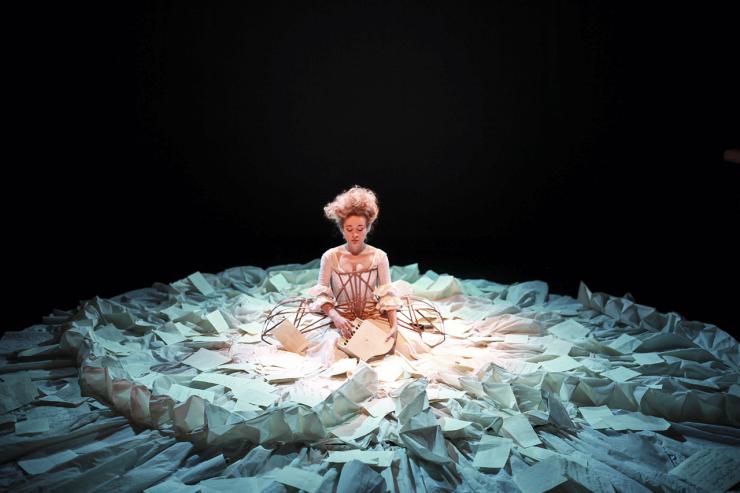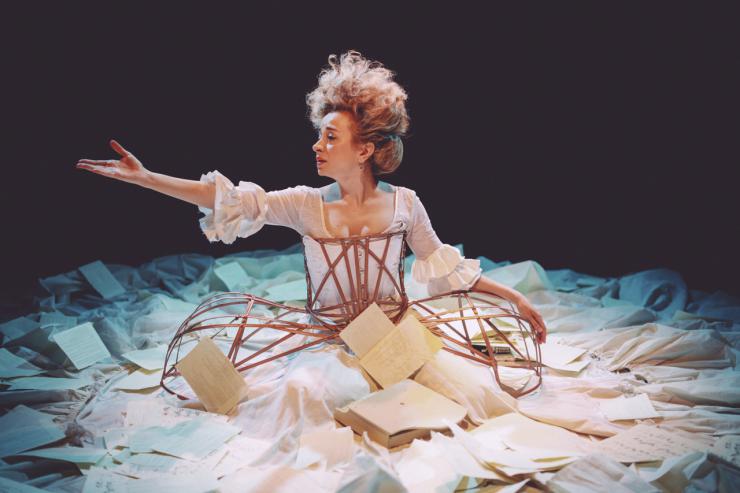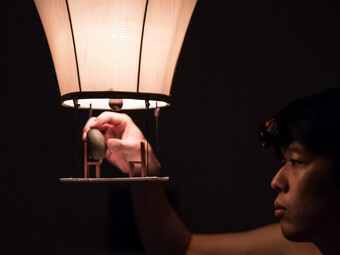Portraying "The Other" in Performance
Sylvia Milo's The Other Mozart
This piece continues a partnership between HowlRound and the League of Professional Theatre Women (LPTW). In 2012, LPTW launched its journal WITOnline, and in 2015, it will become a searchable resource for the field, building a women's history of theatre through in-depth profiles, interviews, and articles. Find all WITOnline-HowlRound content here.
Nannerl was someone who could have had a big life and a game-changing effect on the world. But she didn't. So we had to find, express, theatricalize, why. —Isaac Byrne, director, The Other Mozart
Maria Anna von Berthold zu Sonnenburg, née Maria Anna Walburga Ignatia Mozart, known in intimate circles as Nannerl, and remembered (when remembered) as Wolfgang Amadeus Mozart’s sister, is the subject of the monodrama The Other Mozart. The performance—contained within a striking full-skirted dress worn under panniers whose circumference reaches eighteen feet—is a multi-sensory experience that transports audiences into an evocative, liminal space where Nannerl’s musical virtuosity and ambition is awakened and put in tension with the cultural restrictions and prejudices of her time.
For the past few years I have followed the path of The Other Mozart along with its creator and originating performer, Sylvia Milo. The show has been performed at New York venues such as HERE Arts Center, The Players Theater, amongst others—Milo is now working with several actors including Sara Fellini and Alexandra Schenke to tour the show throughout the US, Europe, and the UK.. Through my affiliation with the show, I’ve been given the opportunity to witness its growth and maturation. Milo has crafted a production that gives autonomy to her subject and organically develops a relationship to the conditions, space, and audience in which it is performed.

Milo found Nannerl Mozart in 2006 while in Vienna. “It was the 250th anniversary of Amadeus’ birth, and Vienna was celebrating. I went there specifically to see The Magic Flute, in the original theatre where it premiered, directed by my favorite theatre director Chrystian Lupa.” Visiting Mozart’s apartment, Milo became transfixed by a very small copy of an oil painting by Johann Nepomuk della Croce titled Family Portrait in which Nannerl and her brother sit playing four hands. “I was shocked that I didn't know about her, that she is not known.”

As Nannerl reached marrying age, Milo found silence. Her musical identity faded away into domestic landscapes.
From Vienna, to Salzburg (homes of the Mozart family), from archives and books, to letters and diaries, Milo spent the following years “looking for Nannerl.” She found traces of her in Notenbuch für Nannerl, a music notebook in which her father wrote pieces for his daughter to learn and play; in announcements where Nannerl received first billing; in reviews; in family correspondence. In The Other Mozart, Leopold Mozart writes to Amadeus about Nannerl:
Our future depends on your abundant good sense. For surely Nannerl did not practice all the days of her life only to use those highly skilled hands for housekeeping!
As Nannerl reached marrying age, Milo found silence. Her musical identity faded away into domestic landscapes.
I found Nannerl to be a woman of great spirit and integrity. We know that performing music, touring was her passion. She did get to experience it to the fullest in her childhood, when she and Amadeus toured through all of Europe, performing at the greatest concert halls, and it must have been a crushing blow to be barred from it after she turned eighteen.
When the 2011 film Mozart’s Sister was released, its highly fictionalized account of Nannerl’s life reinforced Milo’s desire to bring Nannerl’s true story to the stage. The film’s content reinforced her decision to use materials Nannerl encountered during her seventy-eight years of life—domestic objects, instruments, and early writings on the “proper” role of women in society from such illustrious thinkers such as Emanuel Kant and the family’s correspondence—as guideposts with which to structure her monodrama. Milo remarks,
It was through the letters that I got to know this family—their personalities, tactics, meaning behind the words, their love for one another. That was the basis of understanding the facts of Nannerl’s story and making certain decisions of how and why.
The 2011 film also underscored the need to find an evocative title for the piece that would not be confused with the film. Milo decided upon a powerful one, brought to her by composer and collaborator Nathan Davis: The Other Mozart.
The Other Mozart inspired me to think about binaries and how we can subvert a larger construct that too often puts women and men in separate spaces. It brings forth the question: how can we destabilize the dominant gender-normative paradigm in our own theatre work? It calls all of us (women, men, transgender, etc.) to define and master the roles we want to play (director, performer, dramaturg, designer) and create spaces that support every character and story imaginable. It makes me wonder if one way of achieving this community is by consciously working with and engaging the performance of “the other” in subject, structure, and design.
It brings forth the question: how can we destabilize the dominant gender-normative paradigm in our own theatre work?
Consider the film and stage creations about the same subject—Mozart’s Sister and The Other Mozart. Rather than subsume or subordinate her subject as a domestic relation of Amadeus Mozart, Milo’s theatre piece emancipates Nannerl. She gives the subject of her play the autonomy she never had during her life, and allows her first and foremost to be a musician.
This shift from “sister” to “other” is emblematic of the remarkable dramaturgical work that Milo and her team performed. Framing her as the “other” rather than domesticating her as Mozart’s Sister, Milo gives Nannerl autonomy, challenges herself and the artistic team to acknowledge how they each perform subjectivity, and focus on developing strategies for their audience to experience the life and sounds of Nannerl that have been lost to time. Milo found primary source evidence of Nannerl, but none of her compositions and letters. From this lack, Milo and her team bring forward her absent voice in a responsible and evocative manner. Composer and sound designer Nathan Davis, writes beautifully to this point and about his work with composer Phyllis Chen.
We wanted to depict a musical imagination rather than writing anything that could in any way be mistaken for her work. In doing so, we used only instruments and sounds with which she would have been very familiar: clavichords, harpsichords, music boxes, as well as fans, teacups, church bells, etc. As a character or aspect, it is material of an inner life, of potential. It is clearly music of this (current) time, but using sounds that would have been in Nannerl's ears.

The production further explores “othering” through design. As both set and costume (conceived by Milo and Anna Sroka and executed by Magdalena Dąbrowska and Miodrag Guberinic), Nannerl’s dress is simultaneously her playground and prison. Hidden in the folds and pockets are familiar objects—a fan, a teacup and saucer, letters, books—each becomes an instrument for Nannerl to play. The objects’ aura and shapes become the notes of her lost story. The pannier evokes a cage and the volume of fabric it sits upon adds magnitude and weight to this reading. We feel with Nannerl the heaviness and constraint of a patriarchal culture under which her story has been submerged. The audience, transfixed in imagining and discovering Nannerl as her story moves forward, anticipates the moment she will step into the cage.
The Other Mozart asks the audience to acknowledge how we meet, encounter, and engage with theatrical subjects and acknowledges our shared responsibility in conveying a character’s identity and potential. Milo comments,
The only reason we know that Nannerl composed was her brother’s review of a composition she sent him. He praises it in a letter and encourages her to write more. We don’t know if she did. Composing was not encouraged for girls. But we do know from Leopold’s letter to Wolfgang, that she improvised ‘so successfully that you would be astounded.’ Nannerl’s potential is what we show in the final big gesture of the play, the sense of the beauty that we all lost when she was not allowed to pursue her brilliance.
In this last gesture, Milo invites us to share equally in the meaning of theatre and creates the possibility for us to imagine an 18th Century Saint Cecelia, patron saint of female musicians, with us into our 21st Century.










Comments
The article is just the start of the conversation—we want to know what you think about this subject, too! HowlRound is a space for knowledge-sharing, and we welcome spirited, thoughtful, and on-topic dialogue. Find our full comments policy here